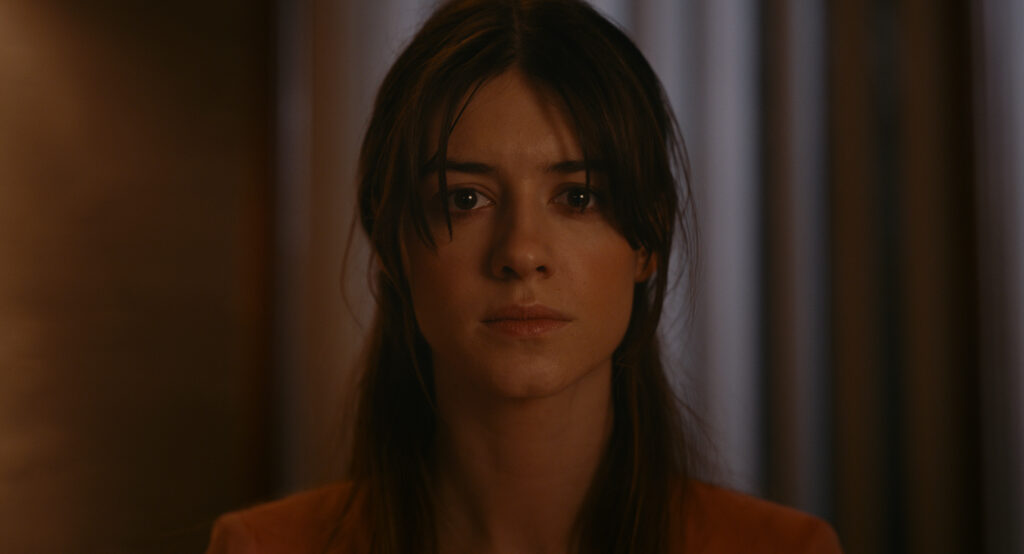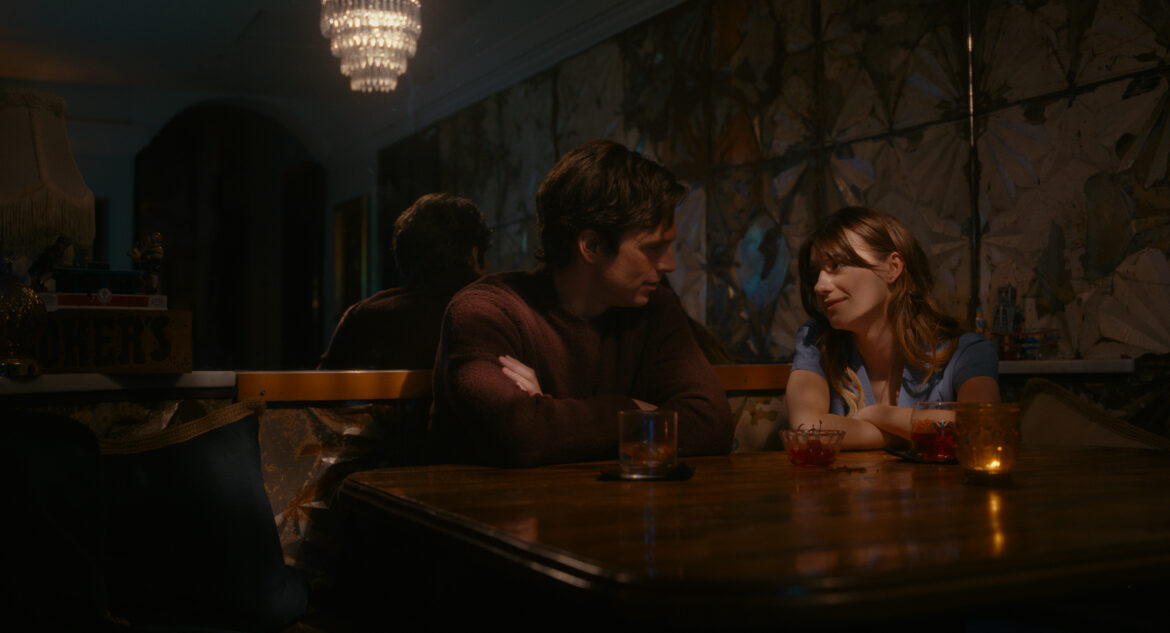By Kirsten Coachman
Modern dating is often not for the faint of heart, from the mindless swiping on apps, the awkward small talk, to the texting of it all. And Noa hates it.
Following her latest dating app disaster, Noa (Daisy Edgar-Jones) crosses paths with a charming stranger, Steve (Sebastian Stan), who chats her up during a late evening of grocery shopping. Before he departs, Steve asks Noa for her phone number, and their fresh produce flirtation later turns into drinks, which quickly evolves into an unexpected, albeit exciting, new life development.
Despite her best friend Mollie’s (Jojo T. Gibbs) skepticism about her social media-less significant other, Noa agrees to go away on a trip with Steve for the weekend. A detour instead leads the pair to Steve’s house for the night, where their relationship begins to approach its expiration date when certain appetites are revealed.

“Fresh” boldly shines a spotlight on aspects of the female experience regarding safety that often go unnoticed while exploring the pitfalls surrounding modern dating. Directed by Mimi Cave (in her feature film debut), written by Lauryn Kahn (“Ibiza”), and produced by Adam McKay and Kevin Messick (“Don’t Look Up”), the richly detailed horror-thriller premiered in the Midnight section at the 2022 Sundance Film Festival this past January and is now streaming on Hulu.
Previously, Edgar-Jones captured audiences in her star-making turn alongside Paul Mescal in the limited series “Normal People,” released in the spring of 2020 on Hulu. Her performance as Marianne garnered awards nominations from Critics Choice, the Golden Globes, and BAFTA TV.
Stan can most recently be seen opposite Lily James, as Mötley Crüe drummer Tommy Lee, in the limited series “Pam & Tommy,” released earlier this year on Hulu. While the actor has impressed in independent features “I, Tonya” (2017) and “Endings, Beginnings” (2019), he’s most known for his role as Bucky Barnes/The Winter Soldier in the Marvel Cinematic Universe. Stan reunited with MCU co-star Anthony Mackie for last year’s “The Falcon and the Winter Soldier” series on Disney+.
Earlier this week, Art U News had the opportunity to speak with Edgar-Jones and Stan during a virtual roundtable interview about making the film, working with Cave, and what they hope audiences take away from their viewing experience.
[Ed note: Specific themes and plot points of “Fresh” are discussed below.]
The film’s premise is very meaty and ambitious—is that what drew you to these roles?
Daisy Edgar-Jones: I felt that when I read it, it was—yeah, ambitious was a word that I thought, too. You know, I think that I’d never read anything like it. I was kind of thinking, how on Earth are they going to strike this sort of tone—like, the balance of the tone—and how are they going to film it? I was really, really curious. So yeah, I think I was drawn to it because I hadn’t read anything like it before. And I thought, “What an opportunity to do something really different.” I knew it was going to be stylishly done, too, because I’d seen Mimi—our director—had made a sizzle reel. She had cut together a trailer for “Fresh” before we’d even started filming for inspiration. And I just thought it was so cool. So I knew it was going to be visually really interesting as well as, you know, the content being interesting too.
This film seems to be playing on some common movie tropes. How do you think each of your characters works to debunk viewers’ preconceived notions about these character tropes throughout the film?
Sebastian Stan: I think it’s just the beginning of the movie that plays against expectations. Our movie works a lot if you don’t know a lot going into it. I feel that it does start out one way, and it has these romantic comedy tendencies, and then halfway through, when the rug gets pulled, it sort of becomes another thing. But you don’t lose the beginning, and you don’t lose them as characters, and you don’t lose whatever that connection—that dynamic—was. You don’t lose it, and it continues. It almost doesn’t stop being a romantic comedy at times. It just becomes that, and this, and something else. I don’t feel like I’ve seen a lot of movies do that.
Just picking up where Sebastian was saying about how the movie was a romantic comedy all the way through, I was wondering how was the collaboration between you two as the relationship between Steve and Noa started to veer off into darker territory?
DEJ: [It was] excellent.
SS: No, it was. Because we shot all the happy—actually, [to Edgar-Jones] you remember this? We said that the movie is like—we used “Blue Valentine” as an example. And I think at the beginning of the movie, we were like, it’s “Blue!” And then the second part of it was like, “Valentine.” And so we were like, “Oh no, the ‘Blue’ is over! We have to go into this space now.” [Laughs]
DEJ: [Laughs] It’s true. I mean, we had such a laugh. I think we were laughing the whole way through making it, which is nice.
SS: It was very fun.
DEJ: Even though there are moments of darkness, you can see that everyone involved is actually having quite a lot of fun. It does translate on screen, too—even in those moments of real horror, in terms of when Noa wakes up and realizes her situation, there is abject terror in it.
SS: Yeah. And that’s about trust, too. You have to balance it out. [When] you’re dealing with serious things, I think you have to balance it out as a way to check in with one another. “How are you doing? Are you still okay? Okay, good.”

You mentioned that it was a lot of fun on set, but was there any particular scene or experience that was challenging for you, or was the shoot kind of smooth sailing throughout?
SS: I mean, there were different challenges. One was the weather for the last part of the film. And then, some of the dancing was challenging in different ways. I think it’s just making sure that those scenes in between—because we always knew where it was going—we had to always see what’s the end of the road. … But then, how we got there, I felt we had to constantly rehearse, shift, and find how each scene builds more and more towards that climax.
DEJ: It was difficult. … There’s such a chess game being played by both the characters. [P]lotting the nuances of that—especially the final dinner scene, because Noa has to be convincing enough that he’s willing to unchain her—and trying to work out how to get there was quite difficult.
What was the most fun or interesting part of the film to shoot?
SS: The fact that it, to some extent, was a relationship movie that was very strange, different, and extreme. There was a romantic comedy part to it that was reminiscent of other films that were lighter and that it had this darker, more grounded, real scary part to it. And then, just the fact that it went back and forth and mixed those genres was different, was interesting. It kept you on the edge of your seat as you were reading it. I guess we were trying to do that going into shooting it.
“Fresh” is director Mimi Cave’s first time directing a movie, although she has some experience with short films and music videos. What was your experience like working with her, navigating this all with her?
SS: It was really great. She was extremely prepared and had a very specific point of view of the movie. And obviously, she has a background in music and dance, and those were all themes in the movie. But I think one thing that she really understood was just the way the movie needed to feel and how it should be shot, so that it remains visually engaging, even in the slower, more talking parts of the movie. I think she was even careful with the violence of it all, but to keep the tense moments [as] the more frightening things about it rather than overdoing things. I felt like she had a real good sense of the story in the film.

The relationship between Noa and Steve shifts considerably throughout the movie. How did you both go about crafting and tracking the progression of this relationship?
DEJ: That was a really important thing for us both and quite difficult. There’s the sort of dynamic between them; it’s so nuanced, and it shifts so subtly, and I think plotting it really was something we spent a lot of time on. We would rehearse scenes on the weekends and things like that. There’s a really tricky part in the middle section of the film where both of them just don’t know what the other is feeling and, ultimately, Noa has to convince Steve of something [for] her to try and save herself. So trying to track that was really difficult, but I guess we found this sort of shared sense of dry humor quite immediately.
SS: Yeah, and it’s all in [the] beginning, which was really important because it sets the whole tone of the movie. You have to really believe that they genuinely connect in some way so that you stay throughout it with them.
Dark humor permeates throughout “Fresh,” and I’m curious about how you both looked to balance that humor with the gravity of the situation taking place between your characters in your performances.
DEJ: It was really great because it was there in the script when we read it. Lauryn struck that balance with the darker bits and then had this crazy ’80s vibe playing alongside it. And so that tone was always there. It was really fun filming that, but it was important to ground every moment of truth that we possibly could to earn those more surreal moments as the film goes on.
In the end, the love that appears stronger is that between Noa and Mollie. How do you think the story of friendship, especially between women, rings throughout the story? And Daisy, how do you think this found its way into your performance?
DEJ: I love that question. That’s definitely something I really loved in the script too. I thought that it really celebrated female friendships in a way that you don’t always see on camera. I mean, the true love story is between Mollie and Noa, and I hope I have a friend like Mollie because she’s just the best friend you could ever ask for. One of the things that [the film] explores is how these women—through sharing their experiences with each other [and working together]—overcome their situation. And I love that ultimately they saved themselves. They’re not saved—it’s their strength that gets them through. And I just think it’s really important to celebrate friendships like that on screen.
What do you hope that people take away from the film?
SS: Awareness, certainly, about narratives that we grew up with and how they may or may not influence our decisions when we meet people and what we look for, I guess, or what we’ve been told to look for, by the way we grew up or consumerism or movies even. I think this was a very different telling of a meeting between two people that starts off one way and becomes something else. And there’s a lot that appears to be a certain way and then gets revealed later. I feel like we’re just hoping people can understand the undercurrents and the theme of the movie while going on the journey.
“Fresh” is now streaming on Hulu. This interview has been edited for length and clarity.
